UAV, GIS, and Petrographic Analysis for Beachrock Mapping and Preliminary Analysis in the Compressional Geotectonic Setting of Epirus, Western Greece
Abstract
:1. Introduction
2. Geological Setting of the Study Area
3. Mapping and Sampling Methods
4. Mineralogical and Petrographic Analyses
4.1. Analytical Methods
4.2. Mineralogical Analyses and Microstructures Representative XRD Analysis
4.3. Petrography under Polarizing Microscope and SEM Analysis
5. Discussion
6. Conclusions
Author Contributions
Funding
Data Availability Statement
Conflicts of Interest
References
- Lambeck, K.; Chappell, J. Sea Level Change through the Last Glacial Cycle. Science 2001, 292, 679–686. [Google Scholar] [CrossRef] [PubMed]
- Yokoyama, Y.; Lambeck, K.; De Deckker, P.P.J.; Fifielf, L.K. Timing of the last glacial maximum from observed sea-level minima. Nature 2000, 406, 713–716. [Google Scholar] [CrossRef]
- Peltier, W.; Fairbanks, R. Global glacial ice volume and Last Glacial Maximum duration from an extended Barbados sea level record. Quat. Sci. Rev. 2006, 25, 3322–3337. [Google Scholar] [CrossRef]
- Siddall, M.; Rohling, E.J.; Almogi-Labin, A.; Hemleben, C.; Meischner, D.; Schmelzer, I.; Smeed, D.A. Sea-level fluc-tuations during the last glacial cycle. Nature 2003, 423, 853–858. [Google Scholar] [CrossRef] [PubMed]
- Kakroodi, A.A.; Kroonenberg, S.B.; Hoogendoorn, R.M.; Mohammadkhani, H.; Yamani, M.; Ghasssemi, M.R.; Lahijani, H.A.K. Rapid Holocene sea-level changes along the Iranian Caspian coast. Quat. Int. 2012, 263, 93–103. [Google Scholar] [CrossRef]
- Kraft, J.C.; Chrzastowski, M.J. Coastal Stratigraphic Sequences. In Coastal Sedimentary Environments; Springer Science and Business Media LLC: New York, NY, USA, 1985; pp. 625–663. [Google Scholar] [CrossRef]
- Hopley, D. Beachrock as sea-level indicator. In Sea-Level Research: A Manual for the Collection and Evaluation of Data; van der Plassche, O., Ed.; Geo Books: Norwich, UK; pp. 157–173.
- Kelletat, D. Beachrock as Sea-Level Indicator? Remarks from a Geomorphological Point of View. J. Coast. Res. 2006, 226, 1558–1564. [Google Scholar] [CrossRef]
- Cooper, A. Sea Level Studies|Sedimentary Indicators of Relative Sea-Level Changes—High Energy. In Encyclopedia of Quaternary Science; Elsevier BV: Amsterdam, The Netherlands, 2013; pp. 385–395. [Google Scholar] [CrossRef]
- Russell, R.J.; McIntire, W.G. Southern Hemisphere Beach Rock. Geogr. Rev. 1965, 55, 17. [Google Scholar] [CrossRef]
- Stoddart, D.R.; Cann, J.R. Nature and origin of beach rock. J. Sediment. Res. 1965, 35, 243–247. [Google Scholar] [CrossRef]
- Cooper, J.A.G. Beachrock formation in low latitudes: Implications for coastal evolutionary models. Mar. Geol. 1991, 98, 145–154. [Google Scholar] [CrossRef]
- Vousdoukas, M.I.; Velegrakis, A.F.; Plomaritis, T.A. Beachrock occurrence, characteristics, formation mechanisms and impacts. Earth Sci. Rev. 2007, 85, 23–46. [Google Scholar] [CrossRef]
- Arrieta, N.; Goienaga, N.; Martínez-Arkarazo, I.; Murelaga, X.; Baceta, J.; Sarmiento, A.; Madariaga, J. Beachrock formation in temperate coastlines: Examples in sand-gravel beaches adjacent to the Nerbioi-Ibaizabal Estuary (Bilbao, Bay of Biscay, North of Spain). Spectrochim. Acta Part A Mol. Biomol. Spectrosc. 2011, 80, 55–65. [Google Scholar] [CrossRef] [PubMed]
- Danjo, T.; Kawasaki, S. Characteristics of Beachrocks: A Review. Geotech. Geol. Eng. 2014, 32, 215–246. [Google Scholar] [CrossRef]
- Mauz, B.; Vacchi, M.; Green, A.; Hoffmann, G.; Cooper, A. Beachrock: A tool for reconstructing relative sea level in the far-field. Mar. Geol. 2015, 362, 1–16. [Google Scholar] [CrossRef]
- Clark, B.B. Geomorphological features of Mother Ivey’s Bay near Padstow, with an account of the under-cliff bank and intertidal reef of cemented limesand at Little Cove. Trans. R. Geol. Soc. Corn. 1968, 30, 69–79. [Google Scholar]
- Kneale, D.; Viles, H. Beach cement: Incipient CaCO3-cemented beachrock development in the upper intertidal zone, North Uist, Scotland. Sediment. Geol. 2000, 132, 165–170. [Google Scholar] [CrossRef]
- Cooper, J.; Green, A.; Wiles, E. Beachrock morphology and genesis on a paraglacial beach. Sediment. Geol. 2017, 360, 47–53. [Google Scholar] [CrossRef]
- Neumeier, U. Experimental modelling of beachrock cementation under microbial influence. Sediment. Geol. 1999, 126, 35–46. [Google Scholar] [CrossRef]
- Moore, C.H. Intertidal carbonate cementation Grand Cayman, West Indies. J. Sediment. Res. 1973, 43, 591–602. [Google Scholar]
- Beier, J.A. Diagenesis of Quaternary Bahamian Beachrock: Petrographic and Isotopic Evidence. J. Sediment. Res. 1985, 55, 755–761. [Google Scholar] [CrossRef]
- Chowdhury, S.Q.; Fazlul Haq, A.T.M.; Hasan, K. Beachrock in St. Martin’s Island, Bangladesh: Implication of Sea Level Changes on Beachrock cementation. Mar. Geod. 1997, 20, 89–104. [Google Scholar] [CrossRef]
- Tatumi, S.; Kowata, E.; Gozzi, G.; Kassab, L.; Suguio, K.; Barreto, A.; Bezerra, F. Optical dating results of beachrock, eolic dunes and sediments applied to sea-level changes study. J. Lumin. 2003, 102–103, 562–565. [Google Scholar] [CrossRef]
- Alexandrakis, G.; Ghionis, G.; Poulos, S. The Effect of Beach Rock Formation on the Morphological Evolution of a Beach. The Case Study of an Eastern Mediterranean Beach: Ammoudara, Greece. J. Coast. Res. 2013, 69, 47–59. [Google Scholar] [CrossRef]
- Ghandour, I.M.; Al-Washmi, H.A.; Khan, A.A.; Mannaa, A.A.; Aljahdali, M.H.; Jones, B.G. Depositional Setting and Cementation Pattern of Al-Mejarma Beachrocks, Saudi Arabia: A Proxy for the Late Quaternary Red Sea Coastal Evolution. J. Mar. Sci. Eng. 2021, 9, 1012. [Google Scholar] [CrossRef]
- Saitis, G.; Karkani, A.; Evelpidou, N.; Maroukian, H. Palaeogeographical Reconstruction of Ancient Diolkos Slipway by Using Beachrocks as Proxies, West Corinth Isthmus, Greece. Quaternary 2022, 5, 7. [Google Scholar] [CrossRef]
- Saitis, G.; Karkani, A.; Koutsopoulou, E.; Tsanakas, K.; Kawasaki, S.; Evelpidou, N. Beachrock Formation Mechanism Using Multiproxy Experimental Data from Natural and Artificial Beachrocks: Insights for a Potential Soft Engineering Method. J. Mar. Sci. Eng. 2022, 10, 87. [Google Scholar] [CrossRef]
- Malta, J.V.; Castro, J.W.A.; Cabral, C.L.; Fernandes, D.; Cawthra, H.C. Genesis and age of beachrocks on the Rio de Janeiro coastline, Southeast—Brazil. Mar. Geol. 2021, 442, 106649. [Google Scholar] [CrossRef]
- Alexandrakis, G.; Petrakis, S.; Kampanis, N. Integrating Geomorphological Data, Geochronology and Archaeological Evidence for Coastal Landscape Reconstruction, the Case of Ammoudara Beach, Crete. Water 2021, 13, 1269. [Google Scholar] [CrossRef]
- Vianna, M.; Cabral, A.P.; Gherardi, D.F.M. TM-Landsat imagery applied to the study of the impact of global climate change on a tropical coastal environment during the last deglaciation. Int. J. Remote Sens. 1993, 14, 2971–2983. [Google Scholar] [CrossRef] [Green Version]
- Chen, F.; Fan, Y.; Chun, X.; Madsen, D.B.; Oviatt, C.G.; Zhao, H.; Yang, L.; Sun, Y. Preliminary research on Megalake Jilantai-Hetao in the arid areas of China during the Late Quaternary. Sci. Bull. 2008, 53, 1725–1739. [Google Scholar] [CrossRef] [Green Version]
- Velegrakis, A.F.; Trygonis, V.; Vousdoukas, M.; Ghionis, G.; Chatzipavlis, A.; Andreadis, O.; Psarros, F.; Hasiotis, T. Automated 2D shoreline detection from coastal video imagery: An example from the island of Crete. In Proceedings of the Third International Conference on Remote Sensing and Geoinformation of the Environment (RSCy2015), Paphos, Cyprus, 16–19 March 2015; Volume 9535, pp. 495–501. [Google Scholar] [CrossRef]
- Hastie, W.W.; Mthembu, A.T.; Green, A.N.; Bergh, J.V.D. Linking fracturing and rock mechanic properties to the erosion of a beachrock shore platform. Mar. Geol. 2021, 441, 106616. [Google Scholar] [CrossRef]
- Nikolakopoulos, K.G.; Lampropoulou, P.; Fakiris, E.; Sardelianos, D.; Papatheodorou, G. Synergistic Use of UAV and USV Data and Petrographic Analyses for the Investigation of Beachrock Formations: A Case Study from Syros Island, Aegean Sea, Greece. Minerals 2018, 8, 534. [Google Scholar] [CrossRef] [Green Version]
- Daryono, L.R.; Nakashima, K.; Kawasaki, S.; Titisari, A.D.; Barianto, D.H.; Suyanto, I.; Rahmadi, A. Shoreline mapping based on beachrocks identification in Krakal-Sadranan beach, Yogyakarta, Indonesia. Bull. Eng. Geol. Environ. 2021, 80, 2825–2844. [Google Scholar] [CrossRef]
- Poulos, S.; Kapsimalis, V.; Tziavos, C.; Pavlakis, P.; Leivaditis, G.; Collins, M. Sea-level stands and Holocene geo-morphological evolution of the northern deltaic margin of Amvrakikos Gulf (western Greece). Z. Geomorphol. Suppl. Issues 2005, 137, 125–145. [Google Scholar]
- Kolaiti, E.; Mourtzas, N.; Kissas, K.; Antonioli, F.; Lambeck, K. New insights into the uplifted Roman harbour at Mavra Litharia (N Peloponnese, Greece) in the geodynamic context of the southern margin of the Corinth Gulf. Quat. Int. 2019, 508, 23–35. [Google Scholar] [CrossRef]
- Koukouvelas, I.K.; Zygouri, V.; Papadopoulos, G.A.; Verroios, S. Holocene record of slip-predictable earthquakes on the Kenchreai Fault, Gulf of Corinth, Greece. J. Struct. Geol. 2017, 94, 258–274. [Google Scholar] [CrossRef]
- Koukouvelas, I.K.; Piper, D.J.; Katsonopoulou, D.; Kontopoulos, N.; Verroios, S.; Nikolakopoulos, K.; Zygouri, V. Earthquake-triggered landslides and mudflows: Was this the wave that engulfed Ancient Helike? Holocene 2020, 30, 1653–1668. [Google Scholar] [CrossRef]
- Koukouvelas, I.K. Geology of Greece. In Liberal Books; Athens Publishing: Athens, Greece, 2019; p. 343. [Google Scholar]
- Doutsos, T.; Koukouvelas, I.K.; Xypolias, P. A new orogenic model for the External Hellenides. In Tectonic Development of the Eastern Mediterranean Region; Robertson, A.H.F., Mountrakis, D., Eds.; Special Publication; Geological Society of London: London, UK, 2006; Volume 260, pp. 507–520. [Google Scholar]
- Valkaniotis, S.; Briole, P.; Ganas, A.; Elias, P.; Kapetanidis, V.; Tsironi, V.; Fokaefs, A.; Partheniou, H.; Paschos, P. The Mw = 5.6 Kanallaki Earthquake of 21 March 2020 in West Epirus, Greece: Reverse Fault Model from InSAR Data and Seismotectonic Implications for Apulia-Eurasia Collision. Geoscience 2020, 10, 454. [Google Scholar] [CrossRef]
- IGRS & IFP. Étude Géologique de L’Epire (Grèce Nord-Occid.); Technip: Paris, France, 1966; 306p. [Google Scholar]
- King, G.; Sturdy, D.; Whitney, J. The landscape geometry and active tectonics of the northwest Greece. Geol. Soc. Am. Bull. 1993, 105, 137–161. [Google Scholar] [CrossRef]
- Doutsos, T.; Kontopoulos, N.; Frydas, D. Neotectonic evolution of northwestern-continental Greece. Geol. Rundsch. 1987, 76, 433–450. [Google Scholar] [CrossRef]
- Hatzfeld, D.; Kassaras, L.; Panagiotopoulos, D.; Amorese, D.; Makropoulos, K.; Karakaisis, G.; Coutand, O. Micro-seismicity and strain pattern in northwestern Greece. Tectonics 1995, 14, 773–785. [Google Scholar] [CrossRef]
- Kokkalas, S.; Xypolias, P.; Koukouvelas, I.K.; Doutsos, T. Post-Collisional Contractional and Extensional Deformation in the Aegean Region. In Post-Collisional Tectonics and Magmatism in the Mediterranean Region and Asia; Dilek, Y., Pavlides, S., Eds.; Geological Society of America Special Paper: Washington, DC, USA, 2006; Volume 409, pp. 97–123. [Google Scholar]
- Tselentis, G.-A.; Sokos, E.; Martakis, N.; Serpetsidaki, A. Seismicity and Seismotectonics in Epirus, Western Greece: Results from a Microearthquake Survey. Bull. Seism. Soc. Am. 2006, 96, 1706–1717. [Google Scholar] [CrossRef] [Green Version]
- Geological Map of Greece 1/50.000 Kanalakion Sheet, Editions; Institute of Geology and Mineral Exploration: Athens, Greece, 1962–1963.
- Kyriou, A.; Nikolakopoulos, K.; Koukouvelas, I. How Image Acquisition Geometry of UAV Campaigns Aff-ects the Derived Products and Their Accuracy in Areas with Complex Geomorphology. ISPRS Int. J. Geo-Inf. 2021, 10, 408. [Google Scholar] [CrossRef]
- McCutcheon, J.; Nothdurft, L.D.; Webb, G.E.; Paterson, D.; Southam, G. Beachrock formation via microbial dissolution and re-precipitation of carbonate minerals. Mar. Geol. 2016, 382, 122–135. [Google Scholar] [CrossRef] [Green Version]
- McCutcheon, J.; Nothdurft, L.D.; Webba, G.E.; Shuster, J.; Nothdurfta, L.; Patersone, D.; Southama, G. Building biogenic beachrock: Visualizing microbially-mediated carbonate cement precipitation using XFM and a strontium tracer. Chem. Geol. 2017, 465, 21–34. [Google Scholar] [CrossRef] [Green Version]
- Desruelles, S.; Fouache, É.; Ciner, A.; Dalongeville, R.; Pavlopoulos, K.; Kosun, E.; Coquinot, Y.; Potdevin, J.-L. Beachrocks and sea level changes since Middle Holocene: Comparison between the insular group of Mykonos–Delos–Rhenia (Cyclades, Greece) and the southern coast of Turkey. Glob. Planet. Chang. 2009, 66, 19–33. [Google Scholar] [CrossRef]
- Vieira, M.M.; De Ros, L.F. Cementation patterns and genetic implications of Holocene beachrocks from northeastern Brazil. Sediment. Geol. 2006, 192, 207–230. [Google Scholar] [CrossRef]
- Meyers, J.H. Marine Vadose Beachrock Cementation by Cryptocrystalline Magnesian Calcite—Maui, Hawaii. J. Sediment. Res. 1987, 57, 558–570. [Google Scholar] [CrossRef]
- Harris, P.M.; Kendall, C.G.S.C.; Lerche, I. Carbonate Cementation—A Brief Review. In Carbonate Cements: Based on a Symposium Sponsored by the Society of Economic Paleontologists and Mineralogists; Schneidermann, N., Harris, P.M., Eds.; SEPM Society for Sedimentary Geology: Washington, DC, USA, 1985. [Google Scholar]
- Giannikopoulou, A.; Evelpidou, N.; Baziotis, I.; Karkani, A. Coastal geomorphological study of St. George bay, Western Naxos, Greece. Zeitschrift Geomorphologie 2021, 63, 33–41. [Google Scholar] [CrossRef]
- Ramachandran, A.L.; Polat, P.; Mukherjee, A.; Dhami, N.K. Understanding and creating biocementing beachrocks via biostimulation of indigenous microbial communities. Appl. Microbiol. Biotechnol. 2020, 104, 3655–3673. [Google Scholar] [CrossRef]
- Longman, M.W. Carbonate diagenetic textures from near surface diagenetic environments. AAPG Bull. 1980, 64, 461–487. [Google Scholar]
- Calvet, F.; Cabrera, M.; Carracedo, J.; Mangas, J.; Pérez-Torrado, F.; Recio, C.; Travé, A. Beachrocks from the island of La Palma (Canary Islands, Spain). Mar. Geol. 2003, 197, 75–93. [Google Scholar] [CrossRef]
- Çiner, A.; Desruelles, S.; Fouache, E.; Koşun, E.; Dalongeville, R. Beachrock formations on the Mediterranean Coast of Turkey: Implications for Holocene sea level changes and tectonics. Geol. Bull. Turk. 2009, 52, 257–296. [Google Scholar]


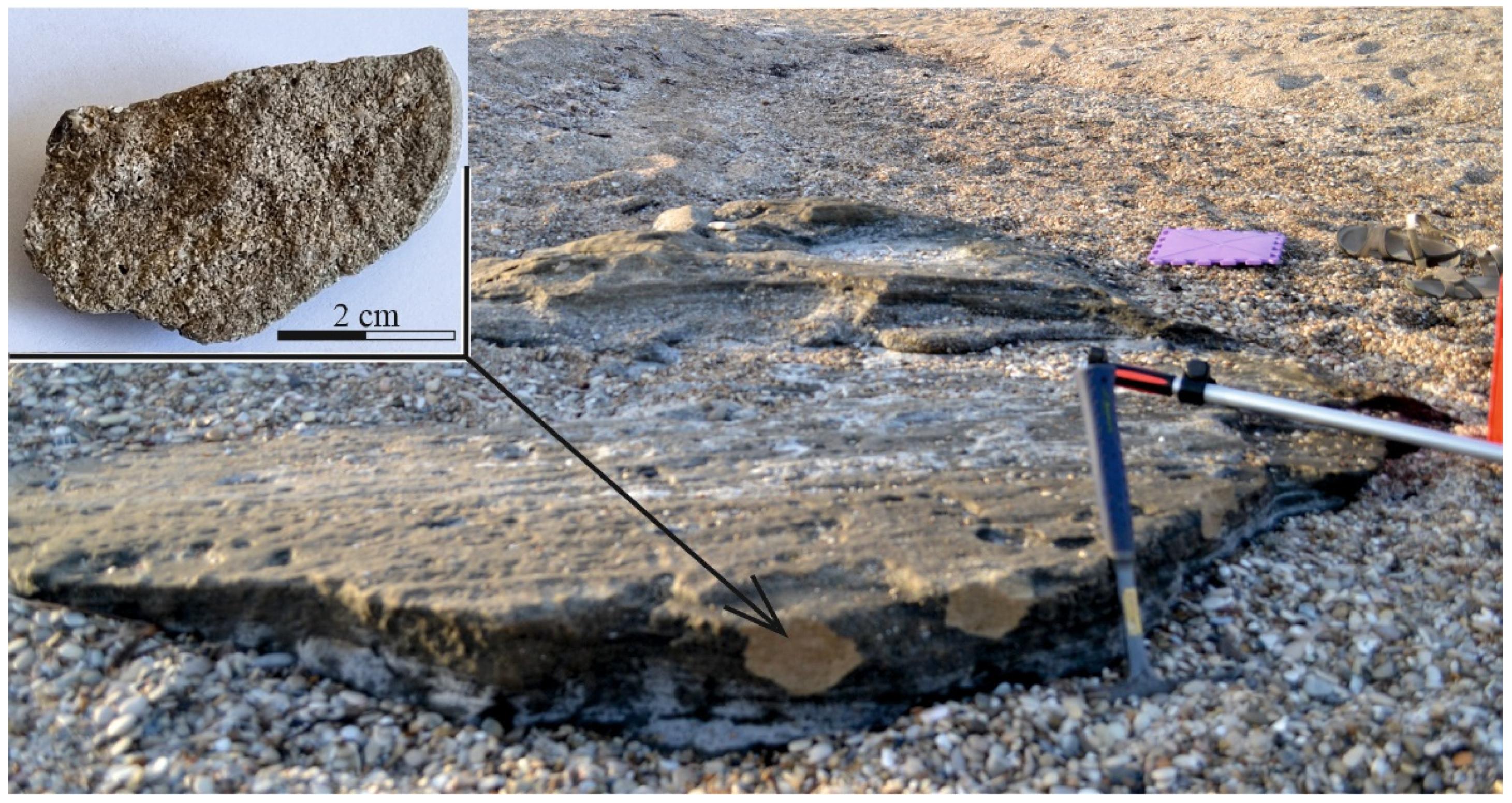
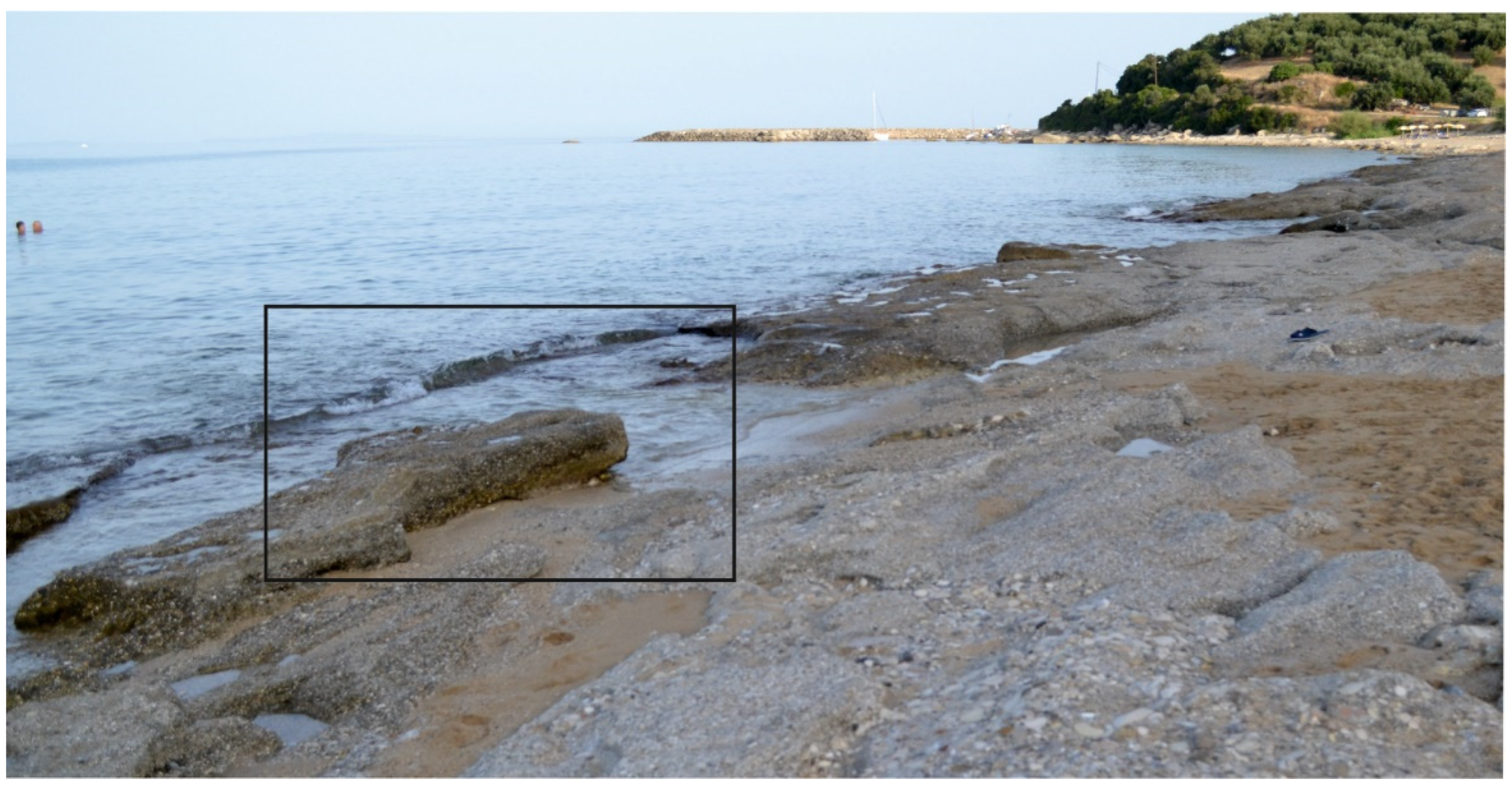
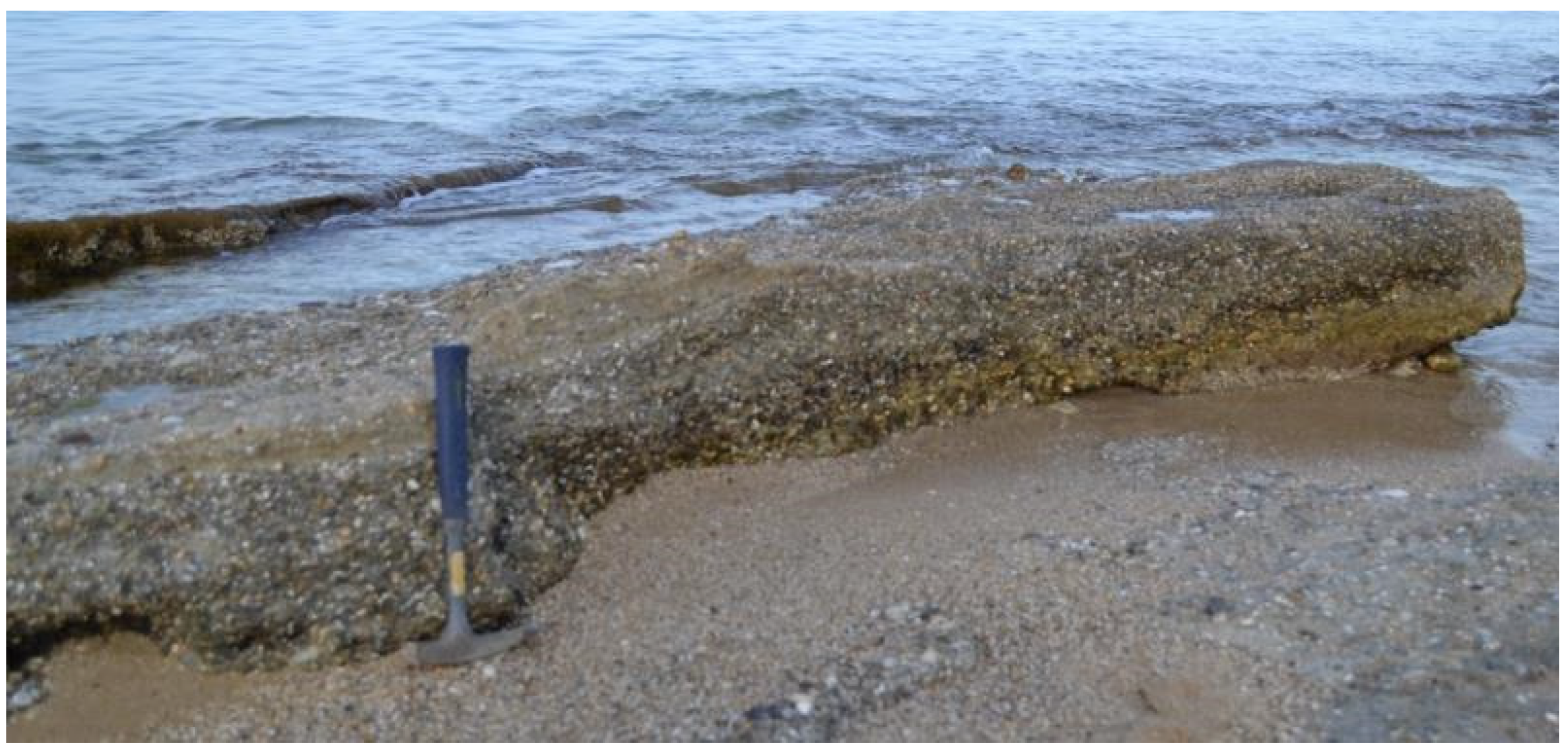
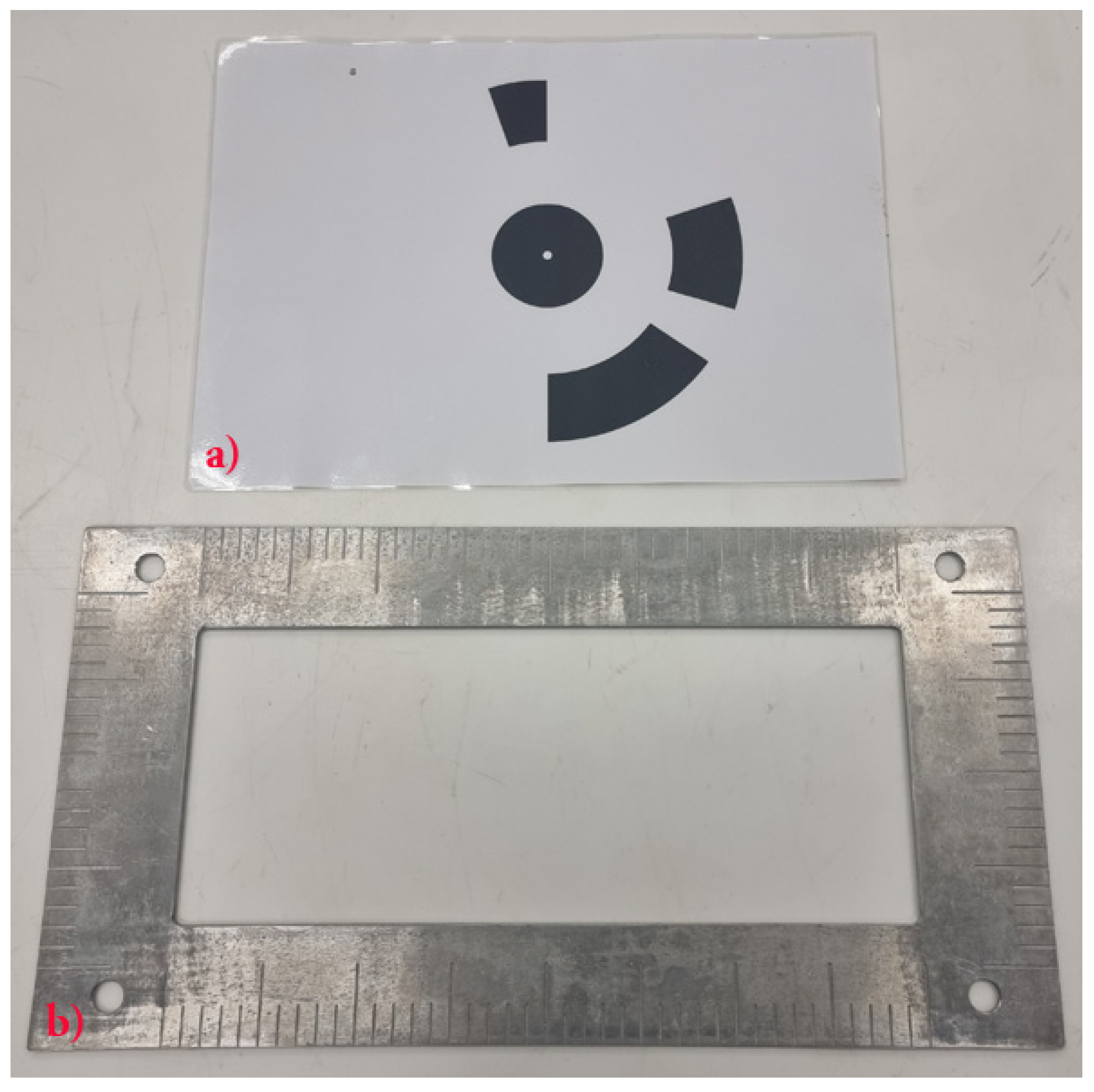

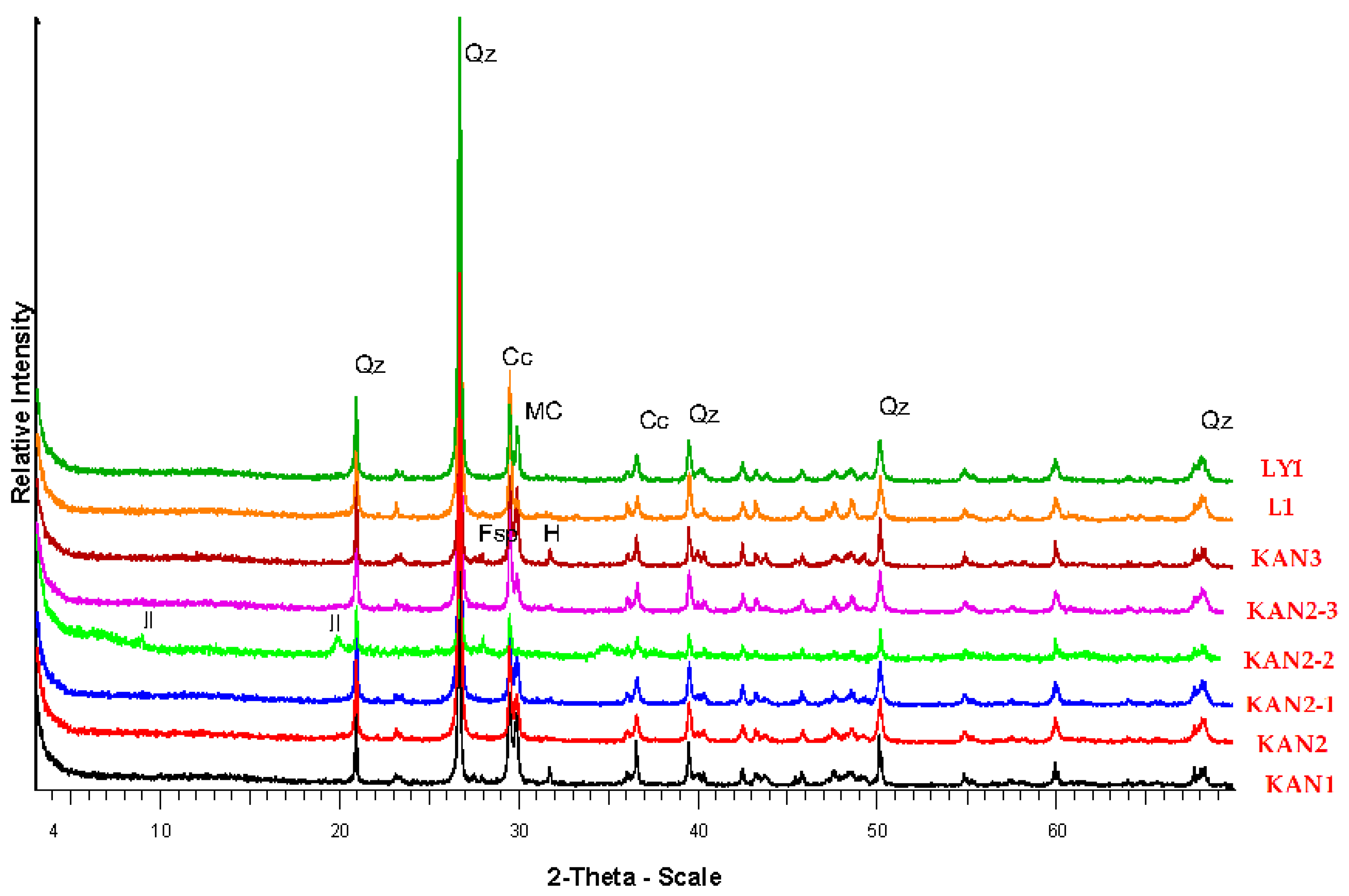
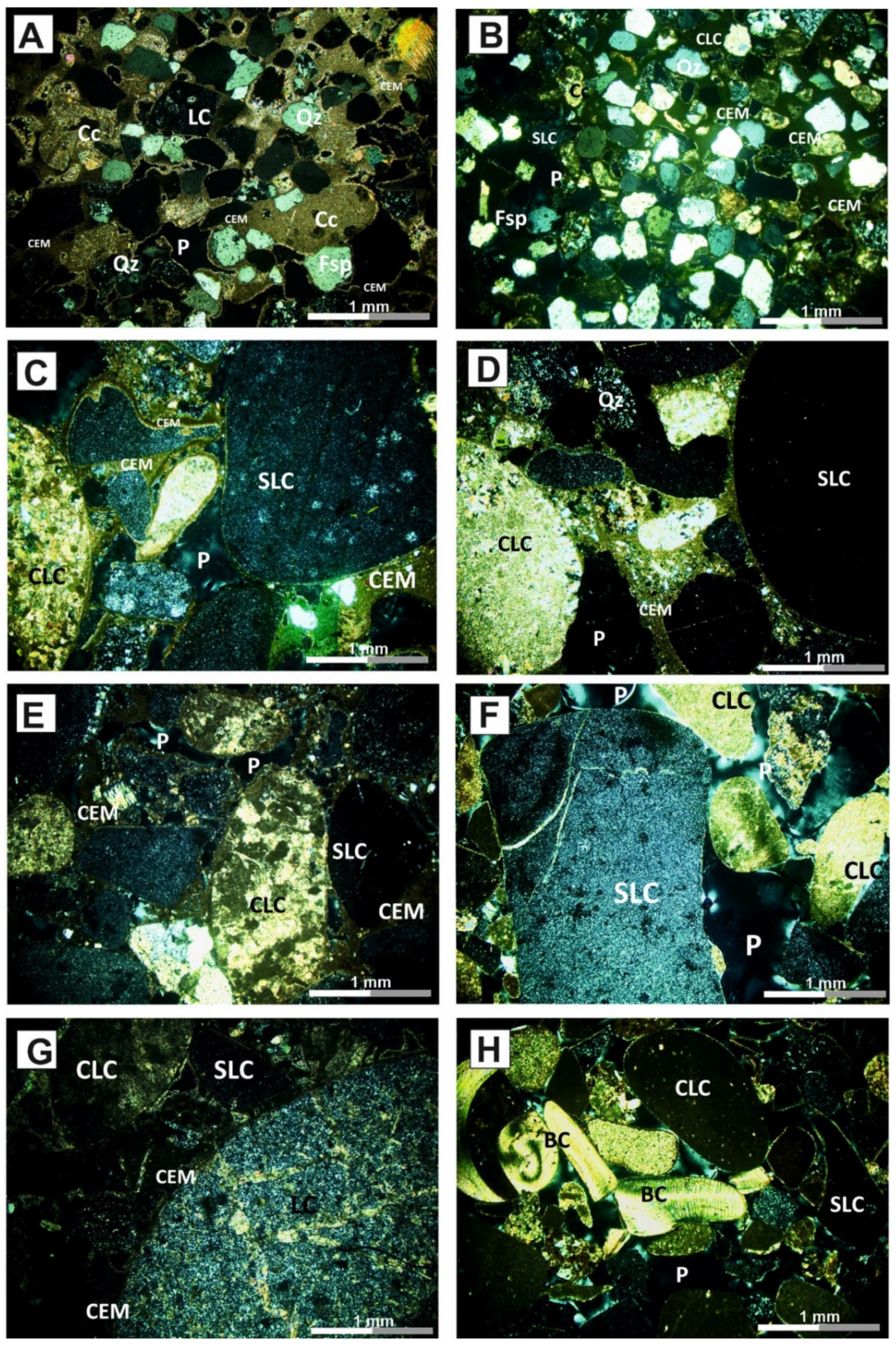
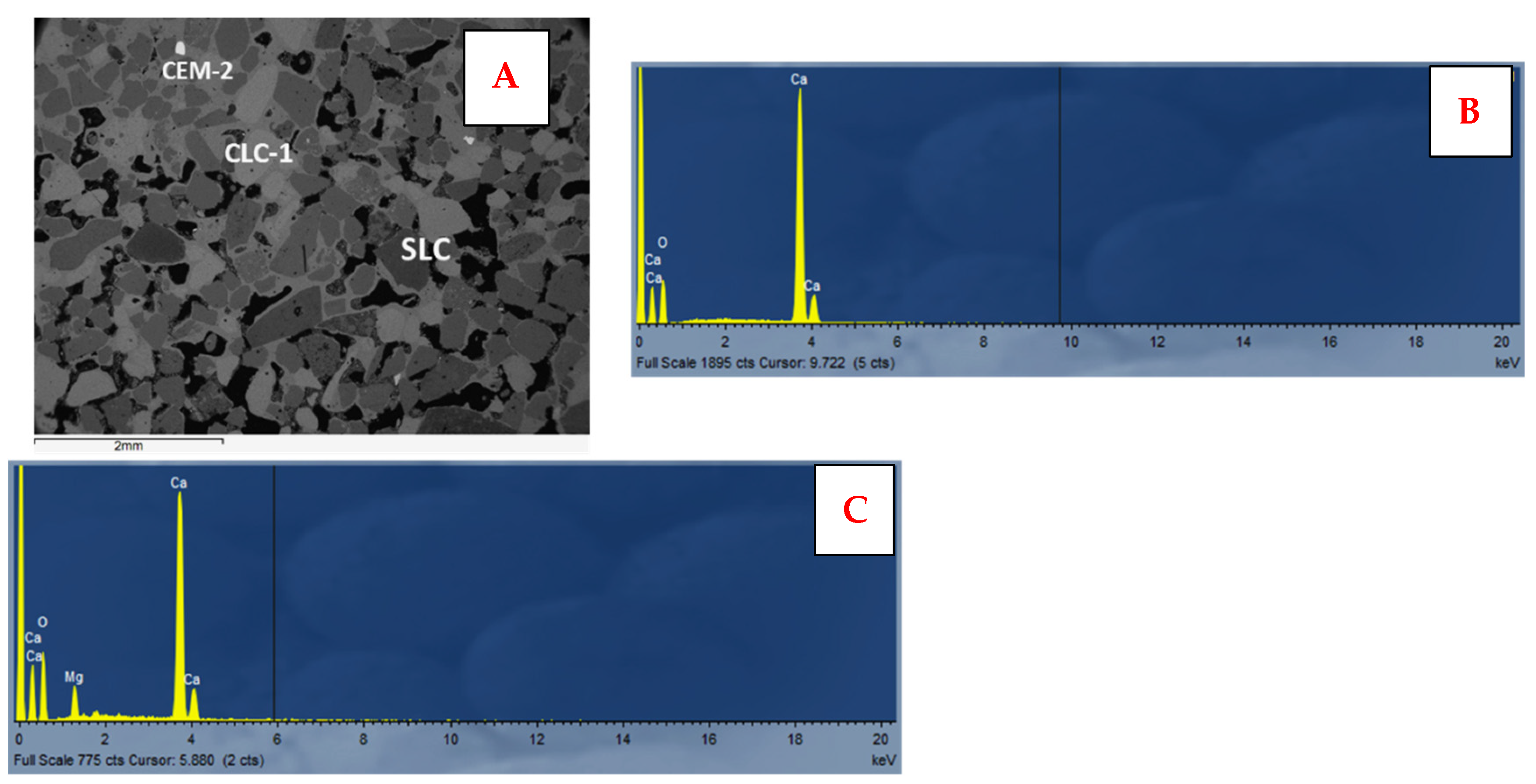
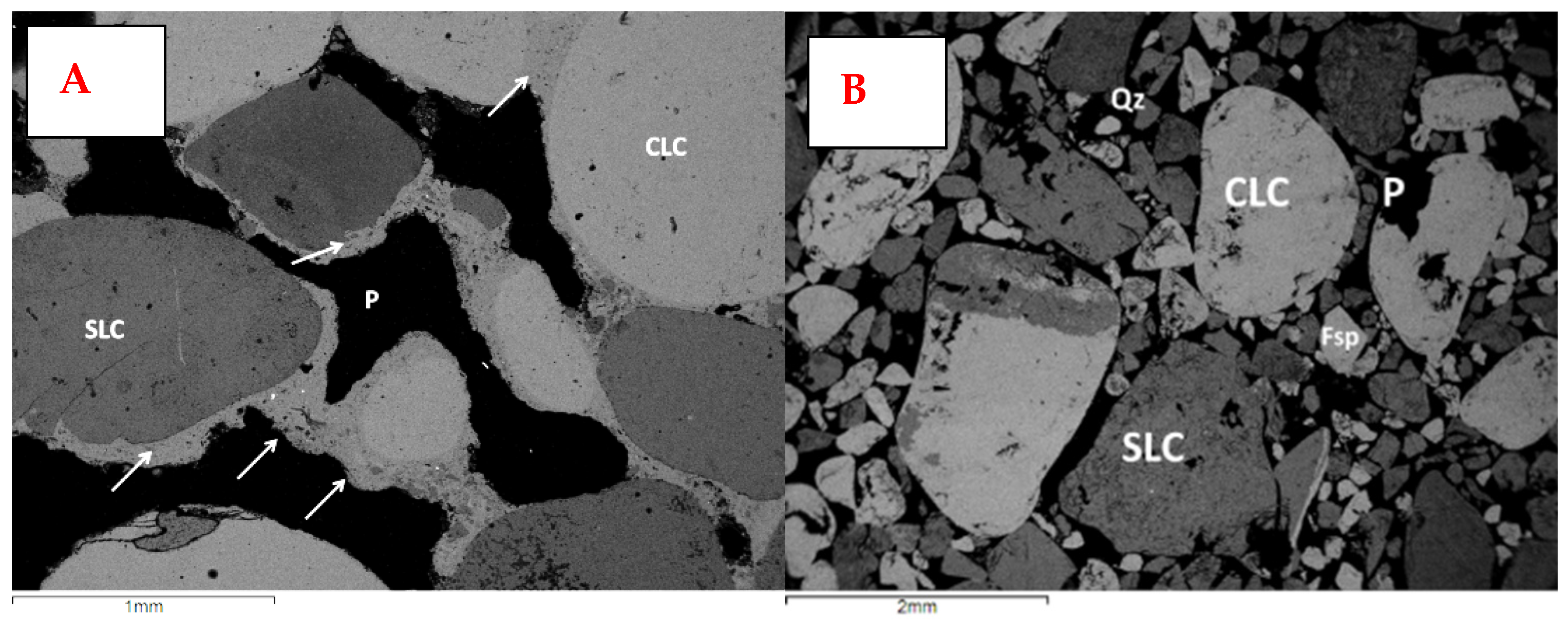
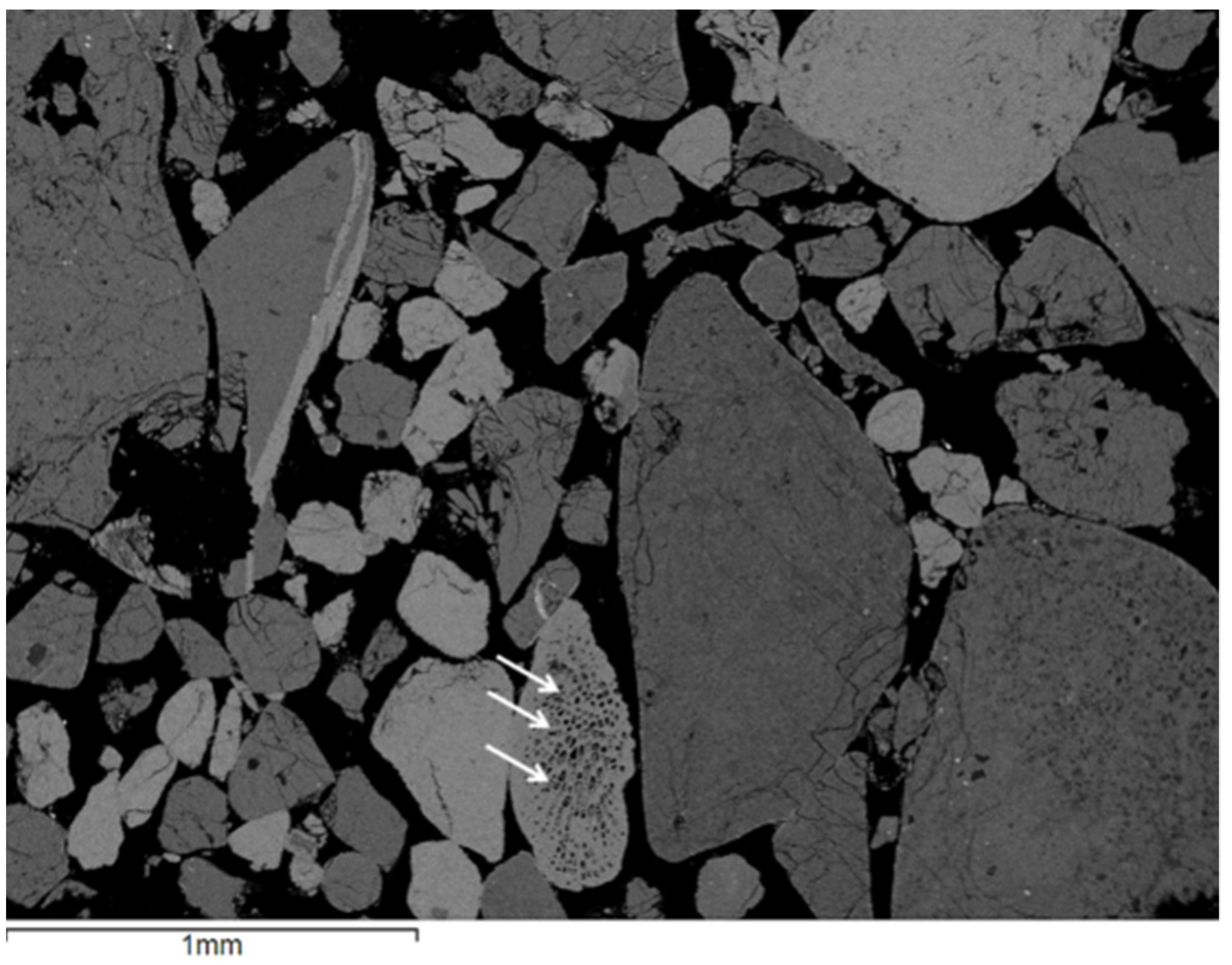
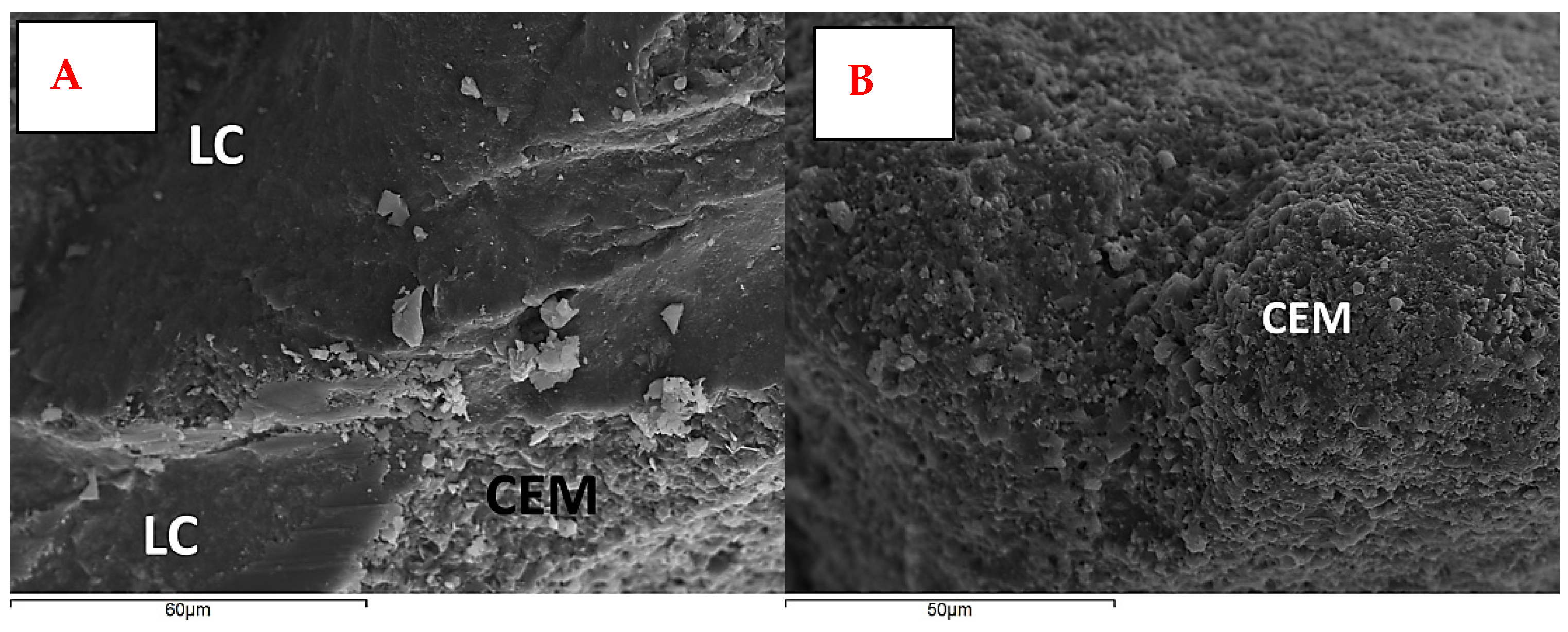



| Sample | Phases wt% | GOF | |||||
|---|---|---|---|---|---|---|---|
| Quartz | Calcite | Mg-Calcite | Illite | Feldspar (Albite) | Halite | ||
| KAN1 | 55 | 21 | 19 | - | 3 | 2 | 1.86 |
| KAN2 | 67 | 12 | 19 | - | 1 | tr | 1.30 |
| KAN2-1 | 71 | 11 | 17 | - | 1 | tr | 1.38 |
| KAN2-2 | 51 | 10 | 0 | 36 | 3 | - | 1.37 |
| KAN2-3 | 69 | 15 | 15 | - | 1 | tr | 1.38 |
| KAN3 | 54 | 12 | 29 | - | 3 | 2 | 1.48 |
| L1 | 70 | 19 | 10 | - | 1 | tr | 1.47 |
| LY1 | 73 | 11 | 15 | tr | tr | tr | 1.40 |
| Sample | KAN1 | KAN2 | KAN2-1 | KAN2-3 | KAN3 | L1 | LY1 |
|---|---|---|---|---|---|---|---|
| Oxide (wt %) | |||||||
| MgO | 6.20 | 6.46 | 6.15 | 9.30 | 6.32 | 6.22 | 7.24 |
| CaO | 49.81 | 49.39 | 49.45 | 46.56 | 49.4 | 49.61 | 48.59 |
| total | 56.01 | 55.85 | 55.6 | 55.86 | 55.72 | 55.83 | 55.83 |
| Mg | 0.154 | 0.160 | 0.153 | 0.231 | 0.157 | 0.154 | 0.180 |
| Ca | 0.888 | 0.881 | 0.882 | 0.830 | 0.881 | 0.885 | 0.866 |
| * Max % mole MgCO3 in HMC | 16 | 18 | 19 | 24 | 17 | 17 | 20 |
| * Min % mole MgCO3 in HMC | 13 | 16 | 12 | 16 | 14 | 13 | 16 |
| * Mean% mole MgCO3 in HMC | 15 | 17 | 15 | 20 | 16 | 15 | 18 |
Publisher’s Note: MDPI stays neutral with regard to jurisdictional claims in published maps and institutional affiliations. |
© 2022 by the authors. Licensee MDPI, Basel, Switzerland. This article is an open access article distributed under the terms and conditions of the Creative Commons Attribution (CC BY) license (https://creativecommons.org/licenses/by/4.0/).
Share and Cite
Nikolakopoulos, K.G.; Koukouvelas, I.K.; Lampropoulou, P. UAV, GIS, and Petrographic Analysis for Beachrock Mapping and Preliminary Analysis in the Compressional Geotectonic Setting of Epirus, Western Greece. Minerals 2022, 12, 392. https://doi.org/10.3390/min12040392
Nikolakopoulos KG, Koukouvelas IK, Lampropoulou P. UAV, GIS, and Petrographic Analysis for Beachrock Mapping and Preliminary Analysis in the Compressional Geotectonic Setting of Epirus, Western Greece. Minerals. 2022; 12(4):392. https://doi.org/10.3390/min12040392
Chicago/Turabian StyleNikolakopoulos, Konstantinos G., Ioannis K. Koukouvelas, and Paraskevi Lampropoulou. 2022. "UAV, GIS, and Petrographic Analysis for Beachrock Mapping and Preliminary Analysis in the Compressional Geotectonic Setting of Epirus, Western Greece" Minerals 12, no. 4: 392. https://doi.org/10.3390/min12040392








